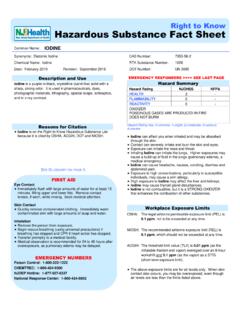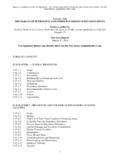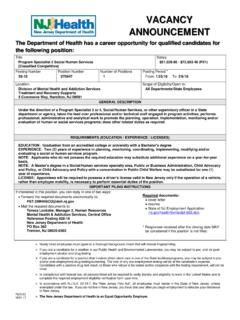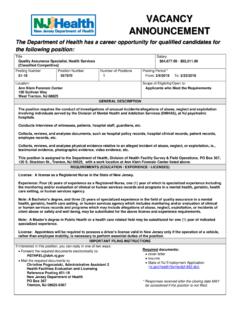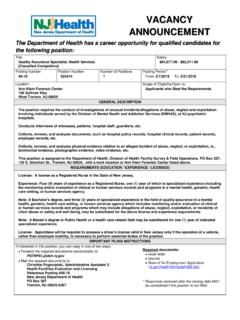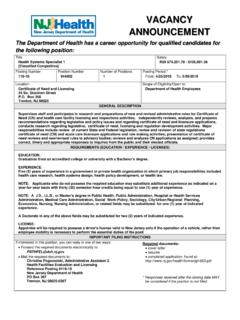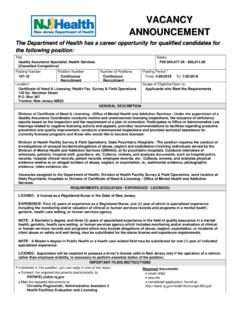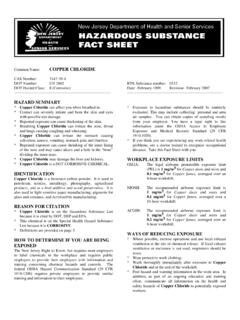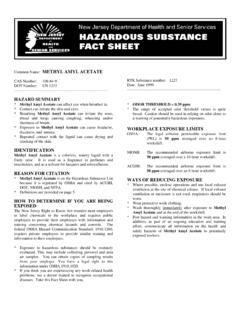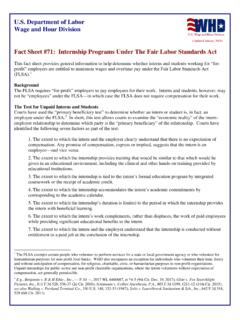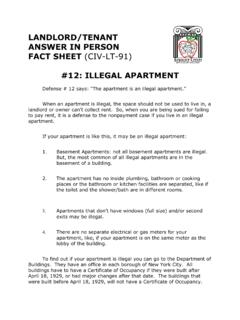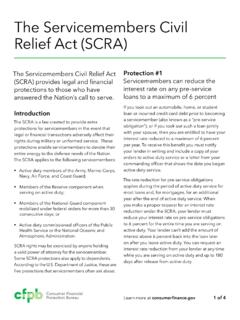Transcription of OXYGEN HAZARD SUMMARY - Government of New Jersey
1 Common Name: OXYGEN . CAS Number: 7782-44-7. DOT Number: UN 1072 (Compressed). UN 1073 (Refrigerated Liquid) RTK Substance number: 1448. DOT HAZARD Class: (Non-Flammable Gas) Date: April 2004 Revision: April 2007. ---------------------------------------- --------------------------------- ---------------------------------------- --------------------------------- HAZARD SUMMARY . * OXYGEN can cause reproductive damage. Handle with * Exposure to hazardous substances should be routinely extreme caution. evaluated. this may include collecting personal and area * OXYGEN may cause mutations. Handle with extreme air samples.
2 You can obtain copies of sampling results caution. from your employer. You have a legal right to this * Contact with liquid OXYGEN can cause severe skin and eye information under the OSHA Access to Employee irritation and burns as well as frostbite. Exposure and Medical Records Standard (29 CFR. * Breathing pure OXYGEN at high pressures can cause ). nausea, dizziness, muscle twitching, vision loss, * If you think you are experiencing any work-related health convulsions (fits), and loss of consciousness. problems, see a doctor trained to recognize occupational * Breathing pure OXYGEN for a long time can irritate the diseases.
3 Take this fact sheet with you. lungs causing coughing and/or shortness of breath. Higher exposures may cause a build-up of fluid in the lungs WORKPLACE EXPOSURE LIMITS. (pulmonary edema), a medical emergency, with severe OXYGEN is naturally present at a concentration of 21% in the shortness of breath. air we breathe. The health effects described in this fact sheet may occur when breathing pure OXYGEN or concentrations IDENTIFICATION greater than 40%. OXYGEN is a colorless, odorless gas. Liquid OXYGEN has a light blue color and is odorless. It is used for resuscitation, in * OSHA defines an OXYGEN -deficient atmosphere as having welding and blast furnaces, as an oxidizer, and in many less than OXYGEN by volume.
4 Industrial processes. * Always monitor OXYGEN levels before entering tanks, vessels, or other confined spaces. REASON FOR CITATION. * OXYGEN is on the Hazardous Substance List because it is WAYS OF REDUCING EXPOSURE. cited by DOT and NFPA. * Where possible, enclose operations and use local exhaust * Definitions are provided on page 5. ventilation at the site of chemical release. If local exhaust ventilation or enclosure is not used, respirators should be HOW TO DETERMINE IF YOU ARE BEING worn. EXPOSED * Wear protective work clothing. The New Jersey Right to Know Act requires most employers * On skin contact with liquid OXYGEN , immediately to label chemicals in the workplace and requires public submerse the affected body part in warm water.
5 Employers to provide their employees with information and * Post HAZARD and warning information in the work area. In training concerning chemical hazards and controls. The addition, as part of an ongoing education and training federal OSHA HAZARD Communication Standard (29 CFR effort, communicate all information on the health and ) requires private employers to provide similar safety hazards of OXYGEN to potentially exposed workers. training and information to their employees. OXYGEN page 2 of 6. this fact sheet is a SUMMARY source of information of all Mixed Exposures potential and most severe health hazards that may result from * Because smoking can cause heart disease, as well as lung exposure.
6 Duration of exposure, concentration of the substance cancer, emphysema, and other respiratory problems, it may and other factors will affect your susceptibility to any of the worsen respiratory conditions caused by chemical exposure. potential effects described below. Even if you have smoked for a long time, stopping now will ---------------------------------------- ---------------------------------- reduce your risk of developing health problems. HEALTH HAZARD INFORMATION WORKPLACE CONTROLS AND PRACTICES. Acute Health Effects Unless a less toxic chemical can be substituted for a hazardous The following acute (short-term) health effects may occur substance, ENGINEERING CONTROLS are the most immediately or shortly after exposure to OXYGEN : effective way of reducing exposure.
7 The best protection is to enclose operations and/or provide local exhaust ventilation at * Contact with liquid OXYGEN can cause severe skin and eye the site of chemical release. Isolating operations can also irritation and burns as well as frostbite. reduce exposure. Using respirators or protective equipment is * Breathing pure OXYGEN at high pressures can cause nausea, less effective than the controls mentioned above, but is dizziness, muscle twitching, vision loss, convulsions (fits), sometimes necessary. and loss of consciousness. * Breathing pure OXYGEN for a long time can irritate the In evaluating the controls present in your workplace, consider: lungs causing coughing and/or shortness of breath.
8 Higher (1) how hazardous the substance is, (2) how much of the exposures may cause a build-up of fluid in the lungs substance is released into the workplace and (3) whether (pulmonary edema), a medical emergency, with severe harmful skin or eye contact could occur. Special controls shortness of breath. should be in place for highly toxic chemicals or when significant skin, eye, or breathing exposures are possible. Chronic Health Effects The following chronic (long-term) health effects can occur at In addition, the following control is recommended: some time after exposure to OXYGEN and can last for months or years: * Specific engineering controls are required for this chemical by OSHA.
9 Refer to the OSHA OXYGEN Standard (29 CFR. Cancer HAZARD ). * OXYGEN may cause mutations (genetic changes). Whether or not is poses a cancer HAZARD needs further study. Good WORK PRACTICES can help to reduce hazardous exposures. The following work practices are recommended: Reproductive HAZARD * OXYGEN may damage the developing fetus. * Eye wash fountains should be provided in the immediate work area for emergency use. Other Long-Term Effects * If there is the possibility of skin exposure, emergency * OXYGEN has not been tested for other chronic (long-term) shower facilities should be provided. health effects. PERSONAL PROTECTIVE EQUIPMENT.
10 MEDICAL. WORKPLACE CONTROLS ARE BETTER THAN. PERSONAL PROTECTIVE EQUIPMENT. However, for Medical Testing some jobs (such as outside work, confined space entry, jobs If symptoms develop or overexposure is suspected, the done only once in a while, or jobs done while workplace following is recommended: controls are being installed), personal protective equipment may be appropriate. * Consider chest x-ray after acute overexposure to compressed or liquified OXYGEN . The OSHA Personal Protective Equipment Standard (29 CFR. ) requires employers to determine the appropriate Any evaluation should include a careful history of past and personal protective equipment for each HAZARD and to train present symptoms with an exam.


